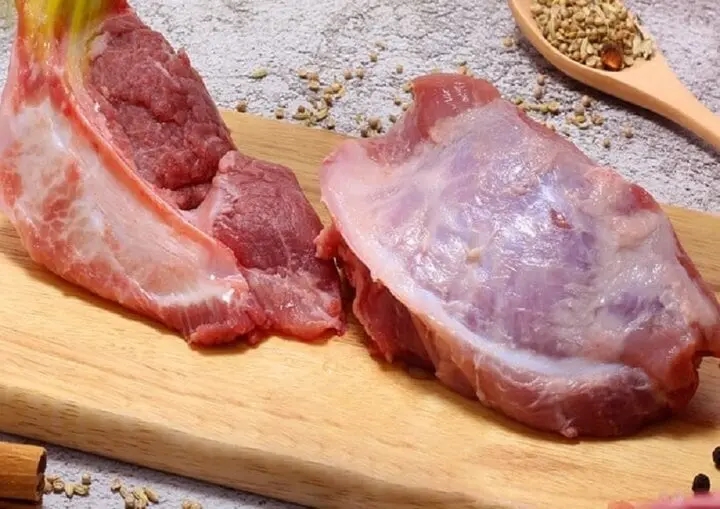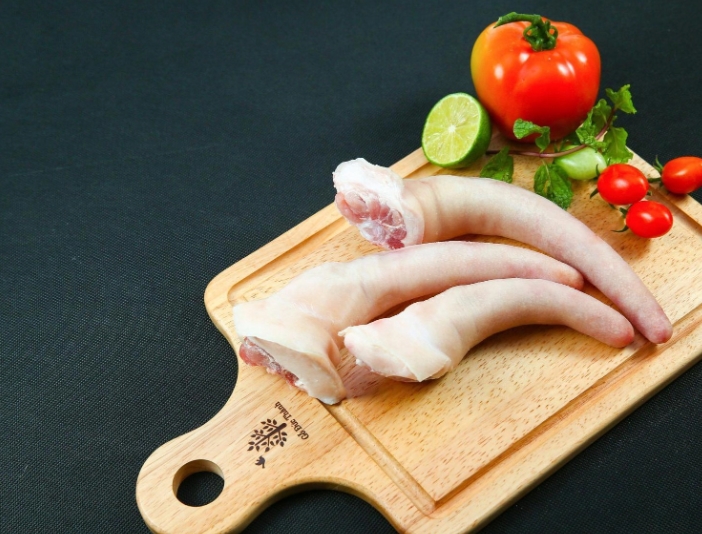When it comes to buying pork, most homemakers tend to opt for popular cuts like pork belly, shoulder, or loin as they are versatile and can be turned into a variety of dishes for family meals. However, for many, the best part of the pig is elsewhere.
The tastiest part of the pig, with only 2kg per animal
Pork cartilage is a delicacy loved by many, but it’s not something that’s on the daily menu for most homemakers. Some people are not fans of it, and it also takes longer to clean and cook compared to other cuts. The main reason for its lack of popularity, though, is its scarcity; there are only about 2kg of this delicious treat per pig, so it’s not always available at the market. Restaurants and pubs often snap it up to create mouth-watering dishes for their customers.
The crescent-shaped cartilage (crescent bone) located at the junction of the front leg is one of the most prized and tasty parts of the pig.
This bone has a curved, crescent-like shape and is mostly made up of cartilage, resulting in a crunchy, tender, and sweet texture. Because of its scarcity and superior taste, butchers often keep it for themselves, sell it to regulars, or offer it to VIP customers.

This is the tastiest part, with only 2kg per pig.
The crescent bone and the surrounding meat are considered the best part of the pig due to their sweet and fragrant taste, tender meat, and crunchy cartilage. Cartilage is rich in collagen, beneficial for joints, skin, and hair, and it helps boost physical strength. It’s especially good for women who want to improve their skin health.
The crescent bone is also a rich source of protein and contains water-soluble nitrogen extracts, providing the body with abundant and high-quality nutrition.
The cartilage of the crescent bone is also packed with calcium, phosphorus, and some vitamins, offering a nourishing boost to the body. Trace elements like vitamins and minerals play a crucial role in nutrition, strengthening the body’s defenses against disease-causing agents.
As there are only about 2kg of this delicious meat per pig, those who want to buy it often have to place a special request with their butcher. This versatile cut can be used in a variety of dishes, especially when grilled. You can also use it in soups or stir-fries.
Other delicious and prized parts of the pig
In addition to the crescent bone, the following cuts are also highly sought-after for their exceptional taste.
Cheek Meat
This cut is considered “5-star quality,” and because of its popularity, it often sells out early in the morning. This is why many people are unaware of its existence.
Pig cheeks come in two parts: the outer cheek and the inner “peach-shaped” cheek. While the outer cheek is tasty, it tends to be fatty. The inner cheek, on the other hand, has a unique texture with soft tendons running through the meat. This cut is perfect for those who don’t like dry, tough, or overly fatty meat.
Loin (Lean Loin)
The loin is a pure lean cut with fine muscle fibers, a high degree of adhesion, a very fragrant smell, and a rich flavor. Its low-fat content makes it suitable for those on a diet or with a sensitive stomach or digestive issues. Recommended cooking methods include boiling, steaming, stir-frying, pan-frying, breaded and fried, braising, and slicing thinly for wrapping. It can also be baked in the oven, grilled, or minced for soups.
Front Leg Shank
The front leg shank is mostly lean, with a deep color, a crunchy texture, and a fragrant aroma. This cut is best suited for stewing, braising, or boiling, and the cooked meat can be sliced and steamed.
Shoulder
The shoulder cut is located at the top, near the backbone of the front leg, right next to the jowl. This cut has a mix of lean meat and fat, with the lean meat being more prominent. The meat is soft and smooth, appealing to a wide range of tastes, and while it has fat, it’s not overwhelming. The shoulder is often minced for meatballs or other minced meat dishes and is also suitable for steaming, pan-frying, and other cooking methods…
Ham (Upper Hind Leg)
This cut, known as the ham or upper leg, is adjacent to the rump near the hind leg. It’s usually very lean, with a fragrant aroma, soft texture, and plenty of juices. The best way to cook it is by hot pot, steaming, boiling, or slicing thinly and stir-frying.
Tail
Each pig has only one small tail, so it’s not always available for purchase. Many butchers even keep the tail for themselves to enjoy at home.

Pig tail is also one of the most nutritious parts of the pig.
The pig’s tail is rich in collagen, which has excellent beauty benefits. It provides high-quality protein, and when consumed in moderation, it can help build muscle without the worry of gaining fat. The tail is delicious when made into soup, boiled, grilled, or braised.
Pig Skin
Many people discard the skin when buying pork, but it’s actually one of the most nutritious parts, offering not just a tasty treat but also beauty benefits.
According to studies, pig skin contains protein levels 2.5 times higher than those found in pork, and its carbohydrate content is four times higher. Moreover, 90% of pig skin is made up of collagen and elastin, substances that can slow down skin aging for women.
Pig skin has a cooling property, a sweet taste, and is effective in hemostasis and blood tonification.
According to VTC News
The Ultimate Guide to Hair Revival: Experts Reveal the 2 Power Ingredients to Transform Fine, Thin Hair
For women struggling with thinning hair, finding the right supplements that genuinely promote hair growth can be challenging. Many fall into the trap of choosing the wrong supplements, which can leave their hair weaker and more problematic. This introduction will reveal the three ingredients to avoid and the two expert-recommended ones to look out for.






































